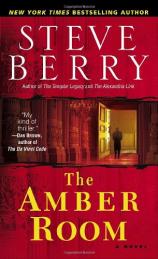Author Talk: October 2003
October 2003
In this interview Steve Berry talks about his debut novel, THE AMBER ROOM. He explains the story of the original Amber Room, the details of its recent restoration and the research involved in writing the book, in addition to offering readers news about his next novel due to be published in September 2004.
Q: What is THE AMBER ROOM?
SB: Created in the mid-18th century, many say it was the greatest achievement man ever accomplished with amber. The room was made of thousands of pieces of jewel grade amber, cut to 5 mm thick, polished, sometimes heated to change the color, then glued jigsaw-puzzle-style onto oak panels which were fashioned to three walls 30 x 13 feet. There were also a variety of fanciful figurines, floral garlands, tulips, roses, sea shells, monograms, and rocaille, all of amber in glittering shades of brown, red, yellow, and orange. Incredibly, the amber panels survived 170 years and the Bolshevik Revolution intact, only to be looted by the Nazis in 1941. The panels disappeared in 1945 and have never been seen since. That, in and of itself, is fascinating. Where did such an incredible treasure go?
Q: Can you tell us a little about the current re-creation of the room?
SB: Some 500,000 pieces of jewel-grade amber were used in the restoration of 1,033 square feet of panels. The 32 black and white photos taken in the 1930s served as the blueprint for re-creating the puzzle. It took twenty years and $11.5 million dollars to complete the effort. The final $3.5 million came from Ruhrgas AG, a German conglomerate. Interesting that, in the end, the Germans made the re-creation possible, but the gesture was viewed as a step toward reconciliation between Germany and Russia over World War II. And it didn't hurt that Ruhrgas buys natural gas from Russia for export. The fall of the Soviet Union dealt the restoration a blow since, before, a Soviet mine supplied the amber at little cost. After, the amber had to bought on the open market, and that can cost anywhere from $300 to $1000 per kilogram (2.2 pounds), depending on quality. Compounding the cost, only 20% of the amber bought is of suitable quality. The rest ends up as dust and chips.
Q: Where did you get the idea to use THE AMBER ROOM in a novel?
SB: In 1995, I was listening to a program on the Discovery channel, not watching, only listening from another room. The narrator was talking about THE AMBER ROOM. I caught only the last few minutes of the show, but the idea fascinated me. Unfortunately, not enough information came from the television show for me to even know what THE AMBER ROOM was. I actually, at first, thought it was a painting. All I learned from the little I heard was that it was stolen from the Catherine Palace in Tsarskoe Selo and had not been seen since 1945. So I went to the bookstore and thumbed through Russian travel guides until I found a reference. It took several more months of research to formulate the novel's plot.
Q: It seems as if so much research went in to the novel--where did you get your information and how much is fact?
SB: When I wrote the first draft in 1995, there were precious few English version texts which dealt with THE AMBER ROOM. The Internet then contained little info, though today it's full of web sites. I spent time in libraries and worked with what I could find, then traveled to St. Petersburg in 1996 to see the work being done on restoring THE AMBER ROOM. The Russians had been laboring on it for over a decade. After spending two hours with the Chief Restorer I realized a lot of what I had written was wrong. So I re-wrote the book. The remaining history dealing with Hitler, Goring, Nazi plunder, lost art, and the Russians is all true. In fact, most of the information contained within THE AMBER ROOM is taken from fact.
Q: How do you balance the amount of factual information and research that went into the novel with the fast pace of the story?
SB: That's something I work on constantly. There's definitely a feel to it. As Supreme Court Justice Lewis Powell once said about obscenity, "I don't know what it is, but I know it when I see it." The same is true about blending information with action. One rule is clear. Action must always come before information. I'm lucky to have an editor who keeps me straight on that.
Q: Is THE AMBER ROOM your first novel?
SB: Actually, it's the fourth novel I've written, but my first one to be published. THE AMBER ROOM was first written in 1995, but it was wholly rewritten in 1996. Later, it was revised, reworked, and modified several times between 1996 and 2002. The version that eventually made it to print is quite different from the original.
Q: What's next for you?
SB: Next is a novel due out from Ballantine Books in September 2004 called THE ROMANOV PROPHECY. It's a contemporary thriller about Russia involving the Romanovs, Fabergé eggs, and Rasputin. I recently spent 10 days in Andorra, the French Pyrenees, and Paris researching a new thriller involving the Knights Templar.




